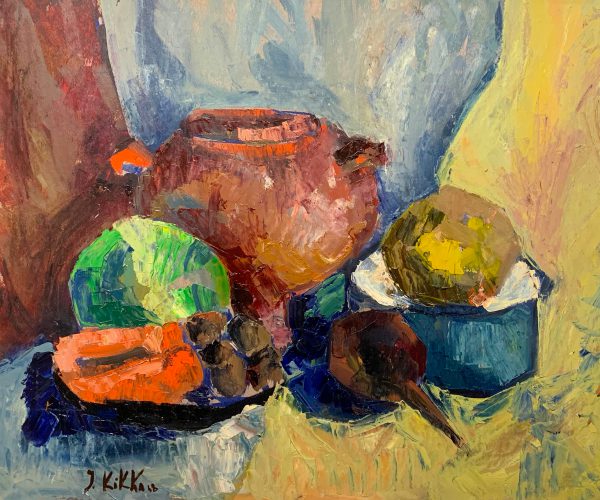Plenitude de la peinture.Nous aimons cette peinture où la matière se décline en harmonie subtiles et colorées.Nous sommes allés plusieurs fois le rencontrer à Tartu chez lui.Juuri Kikka nous a expliqué qu’il avait refusé de suivre les instructions du KGB local en 1970, lui conseillant de peintre un social réalisme convenable, et d’utiliser d’autres couleurs ,acceptables selon le parti.Il choisit la carrière de principal décorateur de la grande usine métallique de Tartu et abandonna un parcours précaire d’artiste pour choisir une voie royale,plus confortable et lui permettant de réaliser et d’exprimer son savoir faire et ses qualités.Ce refus de se soumettre aux instructions du Parti, nous a émus et c’est pourquoi sa peinture retrace une vie d’un artiste peintre doué et ayant refusé la soumission.
Nous l’avons découvert, lors d’une retrospective d’une exposition personnelle en 2019.Il produit en 1967-1970 une expression libre, audacieuse et personnelle que l’on ne retrouve pas dans d’autres peintres Estoniens de l’époque.Il est bien regrettable qu’il est choisi la sécurité matérielle et abandonné la palette.Sa peinture transpose en couleurs chaque éclat lumineux et capte la lumière.
Durant cette période courte de 1967 a 1970, il a développé une touche vibrante et a acquis une expression libre et personnelle qui nous enchanté.Nous avons succombé aux charmes de sa peinture et sa manière de maîtriser la palette. Ses toiles font preuves autant d’audace, de force et de puissance où se dégage la liberté. Sa palette, denote une qualité rare, sinon exceptionnelle et précoce à la Picasso.Picasso à 14 ans a trempé ses pinceaux dans le génie des autres, il imite Corot et Courbet. A 20 ans Picasso voit le bleue Cézannien, il reçoit la lumière et égale les meilleurs Toulouse-Lautrec, Manet.L’age n’a jamais déterminé le génie.________________
ENG version bellowUnheard of on the Estonian artistic market, Juri Kikka is an artist from the Pallas school in Tartu, his teacher was Ilmar Malin from 1967 to 1971.He was particularly influenced by Van Goth and Cezanne whom he admired in their compositions, their very colorful palettes.He envisioned an artistic career and it seemed promising.In 1970 he was invited to KGB having a conversation with a cultural department and got a strict notice about his Art. ” The soviet people, don’t paint this way!”, you should paint only as social realism and abandon your Western way of paintings and forget forever this colorful palette of too vivid colors.
In 1971 he was selected as main Art Decorator of the Tartu factory ”VÕIT” and being in delicacy with the soviet regime of the time, he preferred to seize the career opportunity, a position held until 1991. He organized and participated every year in the universal exhibition from Moscow at VDNX.He could not freely translate his emotions on the paintings, his sources of inspiration and with Tartu finding himself in a position to express himself as a free artist, therefore he opted for financial security and refused a precarious life as a painter.
After 50 years of oblivion, his oils were discovered in the attic of his country house.An exhibition in 2019 held was a real success in Tartu and made it possible to discover him as his palette is really extraordinary flamboyant.Juri Kikka came out of oblivion after 50 years and it’s a story interesting particular of a dissident from Tartu, as an artist, painter which has its own way of expressed choice of existence and above all a refusal to submit.You can admire his paintings, you will be able to dialogue with a past without nostalgia and resemble the breath of freedom.





